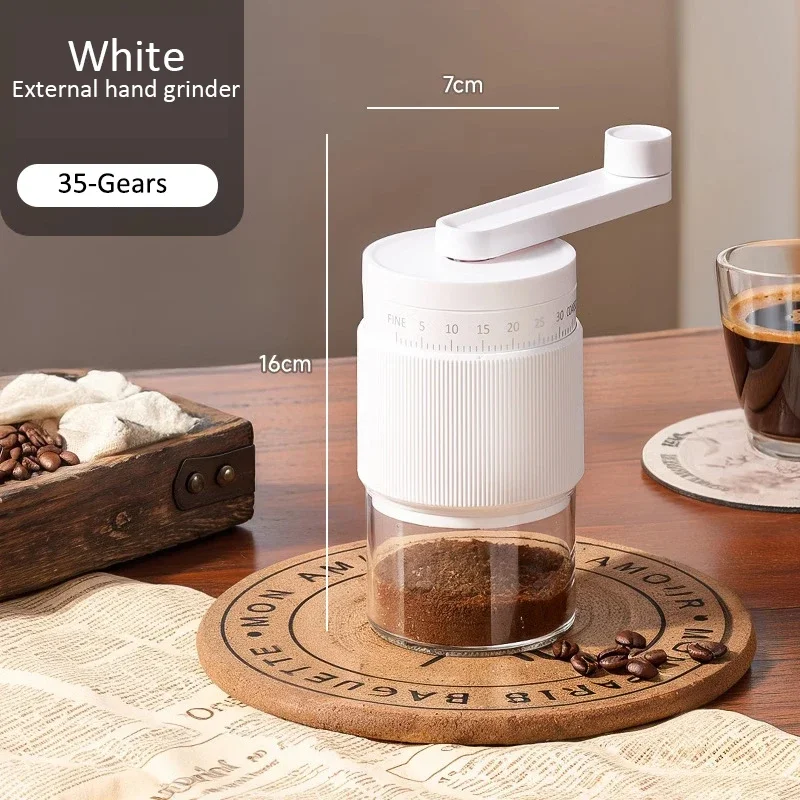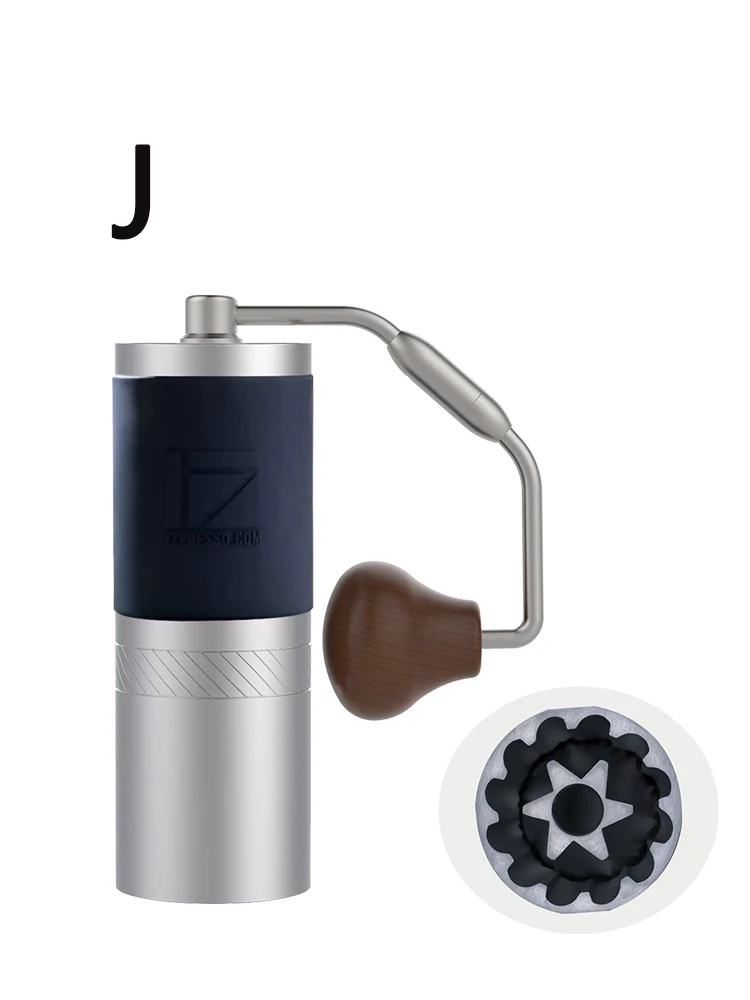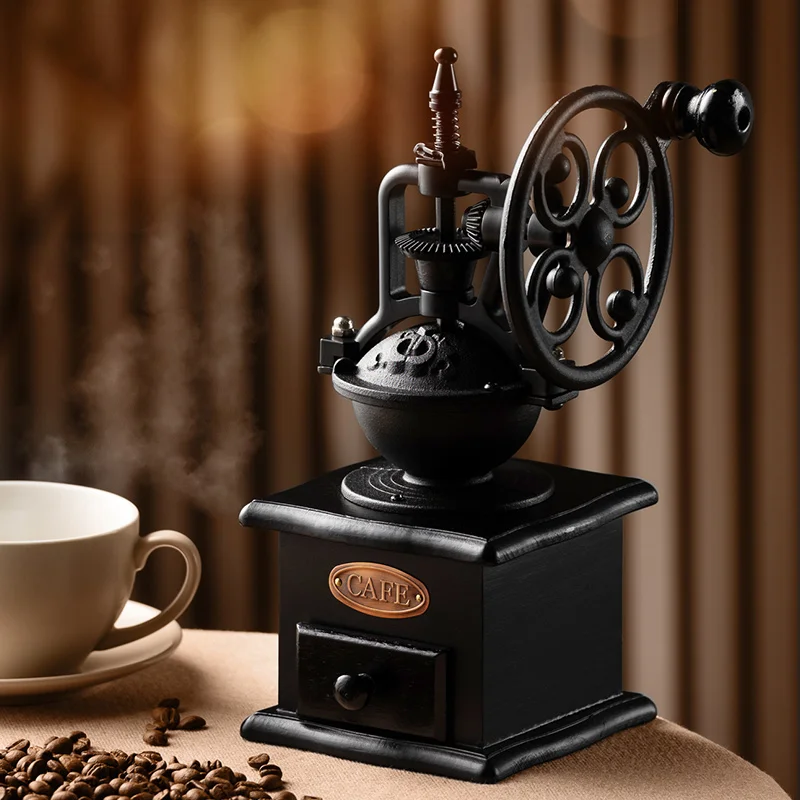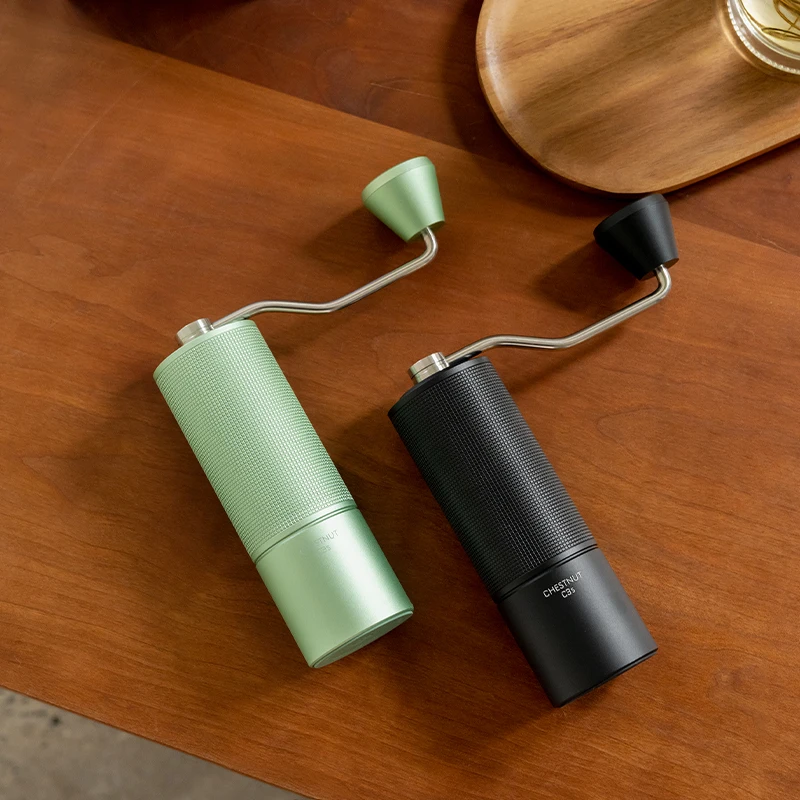The Verdict: Yes, Burr Grinders Are Substantially Better
If you’ve been wondering whether burr grinders are truly worth their higher price tag, the answer is a resounding yes. Burr grinders deliver significantly better coffee by providing three fundamental advantages: consistency in grind size, precise control over your grind, and superior flavor quality in your final cup.
While blade grinders might seem appealing due to their lower cost, they compromise your coffee’s quality in ways that most coffee enthusiasts find unacceptable. The difference isn’t subtle—it’s substantial enough that virtually all specialty coffee professionals and serious enthusiasts exclusively use burr grinders.
This isn’t just marketing hype. The scientific principles of coffee extraction clearly demonstrate why the uniform particles created by comparing burr and blade grinders consistently produce more balanced, flavorful coffee. Understanding these home use considerations between burr and blade coffee grinders will help you make an informed decision about which grinding method best suits your needs.
Understanding Why Grind Quality Matters for Your Coffee
Before diving deeper into grinder comparisons, it’s essential to understand why grind quality fundamentally determines your coffee experience.
The Science of Extraction
Coffee brewing is fundamentally an extraction process. Hot water dissolves compounds from your coffee grounds, pulling out flavors, oils, and caffeine. However, not all compounds extract at the same rate:
– Fruity acids and aromatics extract quickly
– Sugars and pleasant compounds extract moderately
– Bitter compounds extract more slowly
The size of your coffee particles directly controls this extraction rate. Smaller particles extract faster because they have more surface area exposed to water, while larger particles extract more slowly.
The Problem of Uneven Extraction
When your ground coffee contains particles of widely varying sizes (some powder-fine, others chunky), you experience simultaneous under-extraction and over-extraction. This creates a flavor paradox: coffee that tastes both sour (from under-extracted large chunks) and bitter (from over-extracted fine powder) at the same time, missing the sweet balance in between.
The pivotal role your coffee grinder plays in flavor extraction cannot be overstated. Consistent particle size is the foundation for properly extracted coffee, allowing water to extract all particles at roughly the same rate, producing balanced, flavorful results.
Blade Grinders Examined: How They Work & What to Expect
Blade grinders operate using a simple mechanism: a spinning blade chops coffee beans into progressively smaller pieces, similar to how a blender works. Most models feature a single button that activates the spinning blade, which you hold down until you think your coffee is ground sufficiently.
How Blade Grinders Work
- Whole beans are placed in the grinding chamber
- A propeller-like blade spins at high speed
- Beans are chopped repeatedly as they randomly contact the blade
- The user stops the process when grounds appear to be the desired size
Pros of Blade Grinders
- Affordable ($15-40 price range)
- Compact and easy to store
- Simple operation with minimal buttons or settings
- Often available in standard retail stores
Cons of Blade Grinders
- Highly inconsistent grind size, creating a mixture of fine powder and larger chunks
- No precise control over grind size (just grinding duration)
- Generate heat through friction, potentially damaging flavor compounds
- Coffee oils can be burned by the high-speed metal blades
- Challenging to reproduce the same grind consistency between batches
- Limited lifespan compared to quality burr grinders
The fundamental flaw with blade grinders is that beans are randomly chopped rather than purposefully ground to a specific size. Some particles might contact the blade many times, becoming powder-fine, while others might only get chopped once or twice, remaining relatively large. This inconsistency creates the extraction problems discussed earlier.
When choosing between burr and blade grinders, it’s important to recognize these limitations, especially if you’re investing in quality coffee beans that deserve proper treatment.
Burr Grinders Revealed: The Pathway to Better Coffee
Burr grinders represent a fundamentally different approach to coffee grinding that addresses the core limitations of blade grinders. Rather than randomly chopping beans, they crush them between two abrasive surfaces (burrs) with remarkable precision.
How Burr Grinders Work
- Coffee beans enter a hopper and feed into the grinding chamber
- Two burrs (either flat or conical) rotate in close proximity to each other
- The gap between these burrs precisely controls the final particle size
- Beans are crushed progressively smaller as they move through the burrs
- Only particles small enough to pass through the set gap exit the burrs
- This creates a remarkably uniform grind size
Types of Burr Grinders
By Burr Shape:
– Conical Burrs: One cone-shaped burr fits inside another, often preferred for their heat reduction and suitability for various brewing methods
– Flat Burrs: Two parallel rings with teeth, known for extreme consistency but potentially generating more heat
By Power Source:
– Electric Burr Grinders: Motor-driven for convenience and speed
– Manual Burr Grinders: Hand-cranked, offering excellent quality at lower prices, portability, and no electricity requirements
Advantages of Burr Grinders
- Exceptional grind consistency leading to balanced extraction
- Precise control over particle size via adjustable burr distance
- Slower grinding speed generates less heat, preserving flavor compounds
- Repeatable settings allow consistency between brewing sessions
- Better suited for all brewing methods, especially those requiring precise grinds
- Typically constructed with higher quality materials for durability
- Many models feature additional conveniences like timers and dosing features
The superior design of burr grinders means they produce far fewer “fines” (dust-like particles) and “boulders” (oversized chunks), creating instead a consistent particle size that leads to even extraction. The tangible difference a burr grinder makes in your daily coffee experience is immediately noticeable in both taste and aroma.
When selecting a grinder, understanding the differences between flat vs conical burr manual grinders can help you choose the right tool for your specific brewing needs. Browsing quality manual coffee burr grinders reveals the range of options available for various preferences and budgets.

Direct Comparison: Burr vs. Blade Performance
| Feature | Burr Grinder | Blade Grinder |
|---|---|---|
| Grinding Mechanism | Crushes beans between abrasive surfaces | Chops beans with spinning blade |
| Grind Consistency | Highly uniform particle size | Highly variable particles (powder to chunks) |
| Flavor Impact | Clean, balanced, distinct flavor notes | Often bitter and sour simultaneously |
| Heat Generation | Minimal heat transfer | Significant heat from high-speed friction |
| Grind Size Control | Precise, adjustable settings | Limited control (time-based only) |
| Espresso Suitability | Excellent (especially higher-end models) | Poor (cannot achieve consistent fine grind) |
| Pour-Over Suitability | Excellent | Fair to poor |
| French Press Suitability | Excellent | Fair |
| Durability | 5-15+ years with proper care | 2-5 years typically |
| Noise Level | Moderate to low (manual is quietest) | Generally loud |
| Cleaning Requirements | Moderate (requires periodic disassembly) | Simple (but harder to clean oils) |
| Price Range | $50-1000+ | $15-40 |
The most significant differences appear in grind consistency and control. When examining coffee grounds produced by each grinder type, the difference is visually apparent—burr grinders create uniform particles while blade grinders produce a mix of powder and chunks.
This consistency directly impacts extraction. In blade-ground coffee, the fine particles over-extract quickly (creating bitterness), while the larger chunks under-extract (contributing sourness). Burr-ground coffee extracts evenly, allowing the balanced sweetness and complex flavors to shine through.
The specific differences between manual burr vs electric blade grinders offer additional considerations regarding convenience, portability, and power requirements. For those interested in experiencing the difference firsthand, exploring quality hand burr grinder options can be enlightening.
The Science of Extraction: Why Consistency is Crucial
Understanding the science behind extraction helps explain why grind consistency matters so much for flavor.
When hot water contacts coffee grounds, it doesn’t extract all compounds at the same rate. Instead, extraction follows a generally predictable sequence:
1. First: Acids and fruity compounds (contributing brightness)
2. Middle: Sugars and pleasant compounds (contributing sweetness and body)
3. Last: Bitter compounds and plant material (contributing bitterness)
This sequential extraction means timing is critical. With uniformly sized particles, all grounds extract at approximately the same rate, allowing you to stop the process when you’ve captured the desirable compounds but before excessive bitterness develops.
With inconsistent particles, this becomes impossible because:
– Fine particles (called “fines”) over-extract almost immediately, releasing bitter compounds
– Large chunks (called “boulders”) under-extract, never releasing their full flavor potential
– Medium particles extract properly
The result is coffee that tastes both bitter and weak simultaneously—the worst of both worlds. You can’t fix this by adjusting brewing time, as no single duration will properly extract all the different-sized particles.
Achieving perfect grind consistency is therefore not just a preference but a fundamental requirement for properly extracted coffee. This consistency allows water to interact with all particles in a predictable way, enabling proper extraction across the entire batch of grounds.
Value Proposition: Is a Burr Grinder Worth the Investment?
The price difference between burr and blade grinders often gives shoppers pause. Is it really worth spending $100+ on a burr grinder when blade grinders cost under $30? For most coffee enthusiasts, the answer is unquestionably yes.
The True Value Calculation
Flavor Quality Improvement: The difference in taste is significant, not subtle. Many describe it as the single biggest improvement you can make to your coffee setup.
Coffee Bean Savings: Quality beans cost $15-25 per pound. With a blade grinder, their potential is wasted through improper extraction. A burr grinder ensures you get the full value from every bean.
Long-Term Investment: Quality burr grinders last 5-15+ years with proper care, while blade grinders typically need replacement within 2-5 years.
Daily Enjoyment Factor: For a daily coffee drinker, the improved flavor compounds to thousands of better coffee experiences per year.
Specialty Coffee Access: Certain brewing methods (especially espresso) require consistent grinds that blade grinders simply cannot produce.
Different User Scenarios
Casual Coffee Drinkers: Even for occasional coffee drinkers, an entry-level burr grinder around $50-100 provides noticeably better results.
Daily Enthusiasts: For those who brew daily, a mid-range burr grinder ($100-300) offers excellent value over its lifespan.
Serious Home Baristas: Those pursuing espresso or specialized brewing benefit enormously from high-quality burr grinders ($200+).
While burr grinders do have some disadvantages worth considering, most coffee lovers find the benefits far outweigh the higher initial cost. Exploring precision manual grinder options reveals that quality doesn’t always require spending hundreds of dollars—many excellent manual burr grinders deliver outstanding results at accessible price points.

Matching Grind Quality to Your Brewing Method
Different coffee brewing methods require specific grind sizes to achieve optimal extraction. This is where the precise control of burr grinders becomes particularly valuable.
Espresso
- Required Grind: Very fine, consistent particle size
- Why It Matters: Espresso forces hot water through coffee under pressure in 20-30 seconds. Inconsistent grounds create channeling (water finding the path of least resistance), resulting in under-extraction.
- Grinder Performance:
- Burr grinders: Essential for proper espresso. Why burr grinders are essential for espresso explains the technical requirements.
- Blade grinders: Cannot produce the consistent fine grind necessary for espresso.
Pour Over (V60, Chemex, etc.)
- Required Grind: Medium-fine to medium, very consistent
- Why It Matters: Water flows through the grounds by gravity. Inconsistent particles cause uneven extraction.
- Grinder Performance:
- Burr grinders: Create the uniform medium grind needed for clean, balanced extraction.
- Blade grinders: Produce too many fines, clogging filters and causing over-extraction.
Drip Coffee
- Required Grind: Medium, uniform
- Why It Matters: Automatic drip machines need consistent flow rates for proper extraction.
- Grinder Performance:
- Burr grinders: Provide ideal consistency for even extraction.
- Blade grinders: Can work adequately but produce inconsistent results batch to batch.
French Press
- Required Grind: Coarse, consistent
- Why It Matters: Fine particles pass through the metal mesh, creating sediment and bitterness.
- Grinder Performance:
- Burr grinders: Create clean, uniform coarse grounds that extract properly without excessive sediment.
- Blade grinders: Often produce too many fines, resulting in muddy coffee with sediment.
AeroPress
- Required Grind: Variable (fine to medium-coarse) depending on recipe
- Why It Matters: AeroPress is versatile but requires consistency within the chosen grind size.
- Grinder Performance:
- Burr grinders: Allow precise adjustment to experiment with different recipes.
- Blade grinders: Limit the consistency needed for recipe development.
For specific brewing needs like espresso, exploring espresso coffee hand grinders reveals options designed specifically for fine, consistent grinding.
Essential Features to Consider When Buying a Burr Grinder
When shopping for a burr grinder, several key features will determine your experience and results:
Burr Material and Type
- Steel Burrs: Cut grounds more quickly, generally last through 500-1000 pounds of coffee before dulling
- Ceramic Burrs: Generate less heat, may last longer but are more brittle and can crack if foreign objects enter the grinder
- Conical Burrs: Create slightly less heat, often quieter, and typically less expensive
- Flat Burrs: Known for exceptional consistency, particularly valuable for espresso
Understanding the best material for coffee grinders helps make an informed decision based on your specific needs.
Grind Adjustment Mechanism
- Stepped Adjustment: Clicks into preset positions, easier for beginners
- Stepless Adjustment: Infinite adjustment points, ideal for espresso fine-tuning
- Macro/Micro Adjustment: Some grinders offer both coarse adjustments and fine-tuning
Build Quality and Durability
- Frame Construction: Metal frames offer greater stability and durability than plastic
- Burr Mounting: Higher-end grinders have more precise, stable burr mounting
- Motor Quality: Better motors run cooler and last longer (for electric models)
- Bearing Quality: Determines how smoothly and consistently the burrs rotate
Additional Considerations
- Grind Retention: Lower retention means less coffee gets trapped in the grinder
- Static Buildup: Some designs minimize problematic static electricity
- Noise Level: Important for early morning brewing or shared living spaces
- Size and Countertop Footprint: Consider your available space
Fine Adjustment Hand Grinder, Precision Manual Grinder, Travel Coffee Grinder
Price range: $185.11 through $494.63 Select options This product has multiple variants. The options may be chosen on the product pageHand Burr Grinder, Hand Crank Coffee Grinder, Manual Espresso Grinder, Portable Coffee Grinder
Price range: $262.72 through $300.22 Select options This product has multiple variants. The options may be chosen on the product pageManual Burr Mill, Manual Coffee Grinder Stainless Steel, Manual Coffee Mill Grinder, Mechanical Coffee Grinder
Price range: $127.26 through $130.32 Select options This product has multiple variants. The options may be chosen on the product pageHand Burr Grinder, Manual Coffee Grinder Stainless Steel, Precision Manual Grinder
Price range: $183.64 through $187.52 Select options This product has multiple variants. The options may be chosen on the product page
For those seeking durability and premium performance, manual coffee grinder stainless steel options provide excellent longevity and consistent results. Alternatively, if heat resistance is a priority, ceramic burr coffee grinder models offer advantages for preserving delicate flavor compounds.

Maintenance and Care: Keeping Your Grinder Performing at Its Best
Proper maintenance ensures your grinder continues delivering optimal performance while extending its useful life.
Cleaning Frequency
- Daily Users: Deep clean monthly, quick cleaning weekly
- Occasional Users: Deep clean every 2-3 months
- Signs Cleaning is Needed: Static buildup increases, grounds become less consistent, or coffee flavors seem muted
Cleaning Process for Burr Grinders
- Unplug electric grinders (if applicable)
- Remove hopper and any remaining beans
- Remove the upper burr according to manufacturer instructions
- Brush all surfaces thoroughly with a soft brush
- Use grinder cleaning pellets monthly to absorb oils
- Avoid washing burrs with water (can cause rust)
- Reassemble carefully, ensuring proper alignment
Maintenance Tips
- Run a few “sacrificial” beans through after cleaning to remove any remaining dust
- Check for burr alignment periodically
- Keep the grinder in a dry environment to prevent rust
- Follow specific guidance in your manufacturer’s documentation
For detailed guidance specific to hand grinders, the manual burr grinder maintenance guide provides step-by-step instructions to keep your equipment in optimal condition.
Frequently Asked Questions About Coffee Grinders
Can I use a blade grinder for espresso?
While technically possible, blade grinders cannot produce the consistent fine grind required for proper espresso extraction. Espresso requires extremely uniform particles to prevent channeling (water finding the path of least resistance). Using blade-ground coffee typically results in poor extraction, channeling, and unbalanced flavor.
How long do burrs typically last?
Steel burrs generally last through grinding 500-1000 pounds of coffee before noticeably dulling. For a daily coffee drinker making 2-3 cups per day, this translates to roughly 5-10 years of use. Ceramic burrs may last longer but are more susceptible to damage from foreign objects like small stones occasionally found in coffee beans.
Are manual burr grinders as effective as electric ones?
Yes, high-quality manual burr grinders produce grounds just as consistent as their electric counterparts. The primary differences are convenience and speed rather than quality. Many coffee enthusiasts actually prefer manual grinders for their portability, quieter operation, and often lower price point for equivalent grinding quality.
How often should I clean my grinder?
For daily users, a quick brush cleaning weekly and a thorough cleaning monthly is recommended. Coffee oils build up over time and can become rancid, affecting flavor. If your grinder seems to generate more static or your coffee tastes less vibrant, it’s probably time for cleaning.
Does burr shape really matter for home brewing?
For most home brewers, the difference between conical and flat burrs is subtle. Conical burrs are more common in home grinders and work excellently for most brewing methods. Flat burrs are often preferred for espresso due to their extremely uniform particle size. Understanding these differences between burr and regular grinders helps determine which is right for your needs.
For those seeking maximum precision in their brewing, exploring fine adjustment hand grinder options reveals tools specifically designed for exacting control over your grind size.







